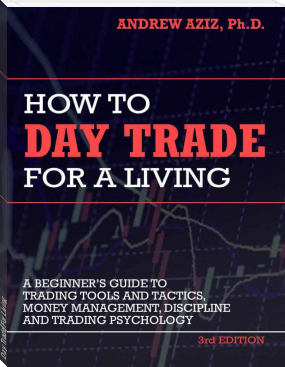Day Trade For Living by Andrew Aziz (epub ebook reader txt) 📕

Read free book «Day Trade For Living by Andrew Aziz (epub ebook reader txt) 📕» - read online or download for free at americanlibrarybooks.com
- Author: Andrew Aziz
Read book online «Day Trade For Living by Andrew Aziz (epub ebook reader txt) 📕». Author - Andrew Aziz
Short selling is generally a dangerous practice in day trading. Some traders are long-biased. They only buy stocks in the hope of selling them higher. I don't have any bias. I will short sell when I think the setup is ready, and I will buy whenever it fits my strategy. Having said that, I am
more careful when I short stocks. Some strategies that I explain in Chapter 7 work only for long positions (Bull Flag and Bottom Reversal). Some strategies work only for short selling (Top Reversal) and others will work in both long and short positions depending on the setup. I explain these positions in detail in Chapter 7.
Individual traders, like you and I, are called retail traders. We can be part time traders, or full-time traders, but we're not working for a firm and we're not managing other people's money. We retail traders are a small percentage of the volume in the market. On the other hand, there are Wall Street investment banks, mutual funds and hedge funds, the so-called institutional traders, and most of their trading is based on sophisticated computer algorithms and high frequency trading. Rarely is any human involved in the day trading operations of these large accounts. Through whatever means, institutional traders have considerable money behind them and they can be very aggressive.
You may correctly ask, "How can an individual trader, like you and me, coming later to the game, compete against institutional traders and win?"
The Achilles' heel of most institutional traders is that they must trade, while individual traders are free to trade or to stay out of the market as they deem best. Banks must be active in the market and trade large volumes of shares at almost any price. An individual trader is free to wait for the best opportunities to arise.
Unfortunately, however, the majority of retail traders fritter away this fantastic advantage by over-trading. An individual who wants to succeed against the giants must develop patience and eliminate greed. The ultimate problem of losers is not their account size but their lack of self-discipline, over-trading, and their bad money management.
I always use the analogy of retail day trading and guerrilla warfare. Guerrilla warfare is an irregular approach to warfare in which a small group of combatants, such as paramilitary personnel or armed civili ans, use hit-and-run military tactics, such as ambushes, sabotage, raids and petty warfare, to maneuver around a larger and less-mobile traditional military force. The United States military is considered to be one of the most formidable fighting forces in the world. However, they suffered significantly as a result of jungle warfare tactics used against them in
North Vietnam. Earlier examples include the European resistance movements which fought against Nazi Germany during World War Two.
In guerrilla trading, as the term suggests, you are in hiding, waiting for an opportunity to move in and out of the financial jungle in a short period of time to generate quick profits while keeping your risk to a minimum. You don't want to defeat or outsmart investment banks. You are simply waiting for an opportunity to reach your daily profit target.
As a retail day trader, you profit from volatility in the market. If the markets are flat, you are not going to make any money; only high frequency traders make money under these circumstances. Therefore, you need to find stocks that will make quick moves to the upside or to the downside in a relatively predictable manner. Institutional traders, on the other hand, are trading with very high frequency and will profit from very small movements of price, or as it is sometimes called, from a "choppy price action".
It is extremely important to stay away from stocks that are being heavily traded by institutional traders. As an individual retail day trader, you must stick to retail trading territory. You will not trade stocks that other retail traders are not trading or not seeing. The strength of retail day trading strategies is that other retail traders are also using them. The more traders using these strategies, the better they will work. As more people recognize the line in the sand, more people will be buying at that point. This, of course, means the stock will move up faster. The more buyers, the quicker it will move . This is why many traders are happy to share their day trading strategies. It not only helps other traders to become more profitable, but it also increases the number of traders who are using these strategies. There is no benefit in hiding these methods or keeping them secret.
As part of the algorithmic trading by computer systems, the majority of the stocks will trend with the overall market unless they have a reason not to. So, if the market is moving up, the majority of stocks will be moving up. If the overall market is going down, the prices of the majority of stocks will also go down. But, remember, there will be a handful of stocks that will buck the trend of the market because they have a catalyst. I call these stocks Alpha Predators . I will explain them in Chapter 4 and
describe how to find them. This is what retail traders are looking for - that small handful of stocks that are going to be running when the markets are tanking, or tanking when the markets are running.
If the market is running, and these stocks are running too, that's fine. You just want to make sure you are trading stocks that are moving because they have a fundamental reason to move and are not just moving with the overall market conditions.
You may ask, what is the fundamental catalyst for stocks that make them suitable for day trading? Here are some examples:
Earnings reports
Earnings warnings/pre-announcements
Earnings surprises
FDA approval/disapproval
Mergers/acquisitions
Alliances/partnerships/major product releases
Major contract wins/losses
Restructuring/layoffs/management changes
Stock splits/buy backs/debt offerings
When I do reversal trades (Chapter 7), my favorite reversal trades are on stocks that are selling off because there has been some bad news regarding that company. If there is a quick sell off because of bad news, many people will notice and start monitoring the stock for what is called a bottom reversal. If stocks are trending down with the overall market, such as oil was some time ago, you cannot do a good reversal trade. Their value pops up by IO cents, and you think it's a reversal, but then they are sold off for another 50 cents. They're selling off because they're trending with both the overall market and their sector. Oil was a weak sector for a while and the majority of the oil and energy stocks were selling off When a sector is weak, that is not a good time for making a reversal trade. That's where have to differentiate.
So here 's the fourth rule of day trading:
has a unique catalyst?"
That's when you have to do a little bit of research. As you become more experienced as a trader, you will be able to differentiate between catalyst based price action and general market trending.
As discussed, as a retail trader, you must be careful that you are not on the wrong side of the trade against institutional traders. But how do you stay out of their way? Instead of trying to find institutional traders, you find out where the retail traders are hanging out on that day and then you trade with them. Think about a schoolyard for a moment. You don't want to be off in the sandbox doing your own thing, trading a stock that no one is paying attention to. You're in the wrong place. Focus where everyone else is focused: focus on the stock that is moving every single day and receiving literally a ton of action. That is what day traders will be looking at. Can you day trade stock like Apple or Priceline or Coca-Cola or IBM? Of course you can, but these are slow moving stocks that are dominated by institutional traders and algorithmic traders, and in general terms they are going to be very hard to day trade. Think of it as the equivalent of hanging out in that isolated sandbox instead of hanging out with your peers in the playground where the cool cats are.
How do you determine what retail traders are focused on and your place in that playground?
There are a couple of ways to find your best place. One is by watching day trading stock scanners. I explain later in Chapters 4 and 7 about how I set up my scanner. The stocks that are gapping significantly up or down are going to be the stocks that retail traders are watching. Secondly, it's good to be in touch with social media and a community of traders. StockTwits and Twitter are usually good places to learn what is tre nding. If you follow a handful of traders, then you'll be able to see for yourself what everyone is talking about. There is a huge advantage to being in a community of traders, such as a chat room, and there are many chatrooms on the Internet.
As the reader of this book, you are welcome to join our private Vancouver Traders chatroom (www.Vancouver-Trade rs.com). We have hundreds of
traders and we are talking about what is hot today. If you're trading completely on your own, you're off in the corner of that proverbial playground. You're not in touch with what other traders are doing, and inevitably you will make it really hard on yourself because you will not know where the activity is. I have tried blocking out social media and trading in a bubble, basically doing my own thing, and it did not work. Draw on the laws of high school survival to guide you!
A little more about what I do: As a day trader, I don't trade based on the company's fundamentals such as product, earnings, earnings-per-share growth and financial statements. I'm not a value investor and I'm not a long term investor. I don't trade Futures either, but I do use Futures to gain an understanding of the overall market direction in the near-term future. I am also a swing trader. In swing trading, I personally do care very much about the fundamentals of the companies I choose to trade: their earnings, dividends, earnings-per-share, and many other criteria. But swing trading is not the focus of this book, so I won' t pursue that





Comments (0)